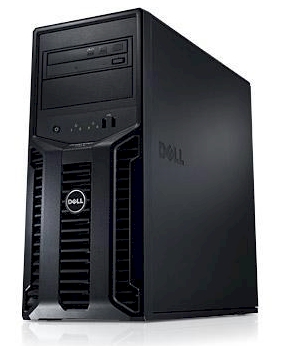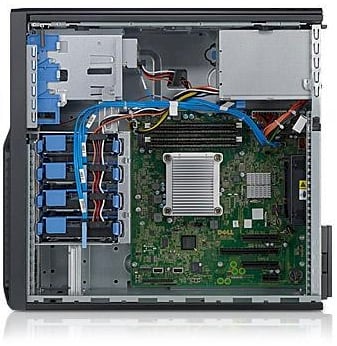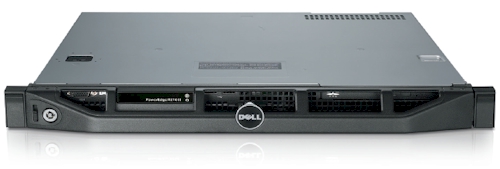Original URL: https://www.theregister.com/2011/04/14/dell_xeon_e3_servers_switches/
Dell uncages Xeon E3 servers for SMBs
Homegrown PowerConnect switches
Posted in Channel, 14th April 2011 19:35 GMT
Dell has made a good living selling single-socket servers to small and medium businesses, and it is out there in front again supporting Intel's just-announced "Sandy Bridge-DT" Xeon E3-1200 processors in its PowerEdge machines.
There are eleven Xeon E3-1200 chips, with four of them being aimed at workstations specifically thanks to the integrated HD Graphics 3000 graphics processors on the die; the other seven can be used in single-socket servers or workstations with discrete PCI-Express graphics cards, which offer better eye candy than the integrated HD Graphics. No matter how the Xeon E3-1200 processors are used, they plug into the new Socket-H2 socket, which is also called the LGA 1155 socket and which is implemented on a platform Intel has code-named "Bromolow".
The Bromolow platform uses the "Cougar Point" chipset that Intel found a bug in back in January and that it has subsequently fixed to keep SATA drives from failing under certain circumstances. The Bromolow server platform offers three different Cougar Point chipsets, and there are eleven others for desktop and notebook PCs, all of which you can see here. The C202 and C204 chips are aimed at entry servers, including micro servers for hyperscale clusters that drive Web applications, while the C206 is aimed at Bromolow platforms that are for workstations using the integrated HD Graphics.
The Bromolow platform only supports a single processor socket and four DDR3 memory slots for that socket. If you want a single socket server that supports six memory slots, you'll have to wait for the "Sandy Bridge-EN" Xeon E5 processors in the third quarter, which will plug into Intel's Socket-B2 socket in one of four different "Romley" server platforms that will span the rest of the Sandy Bridge Xeon lineup.
Dell is kicking out two new Xeon E3 servers today, one in a tower configuration and another in a rack setup. And Dell thinks that SMBs are getting ready to do some upgrading under their desks and in their data closets.

The Dell PowerEdge T110 II entry server
"We still see some customers holding onto their three-year-old servers," Tony Parkinson, director of small and medium business at Dell, tells El Reg. "But I think the cost of running those older platforms is starting to hit home, and other customers are tired of trying to get by with a desktop as a server. They are seeing that there is some sign of economic recovery and they are trying to figure out if their infrastructure can handle growth and new client devices."
The PowerEdge T110 II is the tower server and it is the new entry point in a five-box Xeon tower server lineup peddled by Dell. The T310 is a single-socket Xeon box that has more peripheral expansion than the T110, and the T410, T610, and T710 are progressively beefier two-socket servers. Dell does not do tower servers based on Opteron processors from Advanced Micro Devices (and yes, that is odd).

The cutaway view of the PowerEdge T110 II server
Dell is opting for the C202 chipset in the T110 II server, and supports the full four slots of memory with memory stick capacities of 1GB, 2GB, 4GB, and 8GB at speeds up to 1.07GHz. The C202 chipset supports a mix of speeds on the PCI-Express 2,0 slots, and Dell's mobo has four slots (two x8s, one x4, and one x1). Dell is supporting the quad-core variants of the Xeon E3-1200 processors aimed at servers in the box (not the two-core, low-voltage E3-1220L, which is a 20-watt part aimed at real micro servers).
Most SMB shops using tower servers could care less if their chips burn 45, 80, or 95 watts and will go for the fastest four-core chip their budget will allow. The 3.3GHz E3-1240 would probably be the most popular one, looking at Intel's list prices for 1,000-unit trays of the chips. The 3.5GHz E3-1280 costs almost twice as much and is totally silly, and the extra money you pay for the 3.4GHz E3-1270 is not worth it, either.
If SMB shops want to splurge on anything, it should be on main memory or extra disk capacity – or even perhaps a server virtualization hypervisor. Although to say that is probably sacrilege to Intel.
They call it Cougar Point...
The T110 II server has room for four 3.5-inc SAS or SATA disk drives, and comes with software-based PERC S100 and S300 RAID disk controllers on the motherboard. (This is a Cougar Point chipset feature.) The server can also be equipped with a PERC H200 RAID controller, which is a real card not some software pretending to be one.
Dell is supporting 7.2K and 15K SAS drives and 5.4K and 7.2K SATA drives in the box. It comes with a two-port Intel Gigabit Ethernet NIC on the mobo, and additional Ethernet controllers from Intel and Broadcom are available for plugging into the PCI-Express slots. Dell has slapped a Matrox G200eW video card, a IMPI 2.0-compliant baseboard management controller that hooks into Dell's OpenManage server management tools, and a 305-watt power supply into the chassis.
The Dell T110 II is available starting today, but Dell's online configurator doesn't yet allow you to configure and price up a box as El Reg goes to press. Dell says an entry configuration will cost $635, but that is almost certainly not for a useful machine with proper capacity, an operating system, and support.
The second Dell server coming out today is the PowerEdge R210 II, which has similar feeds and speeds as the T110 II but some differences that rack server buyers want.
The machine has the same single Xeon E3-1200 processor socket and the same four memory slots with a maximum of 32GB of main memory. The same C202 chipset controls the box. But the R210 II has only a single PCI-Express x16 slot (instead of a variety of lower-speed peripheral slots) and only room for two 3.5-inch SATA or SAS disk drives; this server can also be configured with solid state drives if that makes your applications happy. The R210 II comes with a 250 watt power supply and the same Matrox video card and baseboard management controller that is used in the T110 II. A base configuration of the R210 II sells for $925; exactly what is in that configuration is not clear, and again, the online configuration and pricing tools have not yet been updated at Dell to let you go figure it out for yourself yet.

The Dell PowerEdge R210 II rack server
Generally speaking, the new T110 has 50 per cent more disk capacity than its predecessor (six drives compared to four) and twice the memory capacity (32GB instead of 16GB). The R210 has double the memory of its predecessor as well. Both machines have more energy-efficient power supplies as well.
Both the PowerEdge T110 II and R210 II servers support Windows Server 2008 R2, including the Foundation Edition and the new Small Business Server 2011 mashup of Windows, SQL Server, and other servers for SMBs. Parkinson says that he expects for SBS 2011 to be particularly popular on the new tower server.
Switching now to PowerConnect switches
As part of the SMB server rollout today, Dell is also updating its homegrown PowerConnect switches with two new families of devices, the 5500 series and 7000 series.
The PowerConnect 5524 is a fixed-port, top-of-rack Gigabit Ethernet switch with 24 ports and two 10 Gigabit Ethernet uplinks; the switches can be stacked eight high to allow them to be managed as a single logical device. It costs $1,297. The PowerConnect 5528 has 48 Gigabit Ethernet ports plus the two 10GE uplinks; it costs $1,851.
The PowerConnect 7000 series are Layer 3 data center switches. The 7024 model packs 24 ports into a 1U rack-mounted package and deliver 176 GB/sec of aggregate switching bandwidth. The 7024P has 24 ports as well but can support up to 30.8 watts of juice down the Ethernet wire to devices (such as IP telephones) per port. The base PowerConnect 7024 switch and the 7024P has four additional combo ports (which support SFP or standard Gigabit Ethernet ports), while the 7024F has four optional 10GE uplink ports. The 7048 switches doubled the fixed-port count up to 48 and boosts the switching bandwidth up to 224 Gb/sec.
The base 7048 has the four optional SFP or Gigabit Ethernet ports, the 7048P supplies power down the wire on all 48 ports, and the 7048R allows front-to-back or back-to-front cooling. (The R is for Rack.) There is no 7028F model with 10GE uplinks. You can stack up to a dozen of these 7024 or 7048 switches together to create a giant logical switch for network admins to babysit. The 7000 series switches range in price from $3,704 to $6,404, depending on features. ®